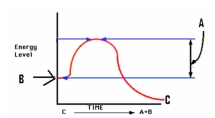A) 6H2O
B) 4H2O
C) 4O2
D) glucose
Correct Answer

verified
Correct Answer
verified
Multiple Choice
Which of the following substrates are required to run cellular respiration?
A) glucose & oxygen
B) glucose & carbon dioxide
C) sunlight & oxygen
D) energy & glucose
Correct Answer

verified
Correct Answer
verified
Multiple Choice
If an organism runs photosynthesis for its main form of energy,the removal of what substrate would limit it's growth?
A) 6H2O
B) C6H12O6
C) 6O2
D) 6CO-
Correct Answer

verified
Correct Answer
verified
Multiple Choice
Which best describes the second law of thermodynamics?
A) Energy is not created nor destroyed,but it can change into matter.
B) Energy is not created nor destroyed,but it can change from one energy form to another.
C) Energy can be created from matter or used to produce matter.
D) Some useful energy is lost as heat whenever an energy transfer occurs.
E) Energy transfers are always 100% efficient in changing energy from one useful form to another.
Correct Answer

verified
Correct Answer
verified
Multiple Choice
While science is not yet able to describe the phenomenon of "thinking" in physical terms,we can be certain that it is a process involving the metabolism of brain cells.With positron emission tomography (PET scan) it is possible to inject short-lived isotopes and image the regions of the brain that have the most active metabolism during various mental activities.For different mental functions,different regions and amounts of nerve cells become active.However,
A) the cellular energy expended in "thinking" must be less than the chemical bond energy supplied in food to these brain cells.
B) "thought" cannot be linked to cell processes because energy is not related to matter.
C) since thoughts can occur over and over,the requirement for a continual input of energy to prevent entropy does not apply to this cell activity.
D) "thinking" is beyond the scope of science to study.
Correct Answer

verified
Correct Answer
verified
Multiple Choice
During oxidation NAD+ will accept ______ but only _______.
A) 2 electrons,1 hydrogen
B) 1 electron,2 hydrogens
C) 2 electrons,2 hydrogens
D) 1 electron,1 hydrogen
Correct Answer

verified
Correct Answer
verified
Multiple Choice
The metabolic pathway at right involves how many possible chemical reactions? 
A) five
B) six
C) one
D) three
Correct Answer

verified
Correct Answer
verified
Multiple Choice
All of the biochemical pathways in a cell constitute
A) coupling reactions.
B) free energy.
C) endergonic reactions only.
D) exergonic reactions only.
E) metabolism.
Correct Answer

verified
Correct Answer
verified
Multiple Choice
Which of the following statements about high energy electrons and NADH is correct?
A) NAD+ will capture two electrons and one H+ in order to make NADH.
B) NAD+ will capture one electron and two H+ in order to make NADH.
C) NAD+ will capture 2 electrons and one H+ in order to make NADPH.
D) NAD+ does not require electrons or H+ in order to make NADH.
Correct Answer

verified
Correct Answer
verified
Multiple Choice
If there are twelve different intermediate products produced in the stages of a metabolic pathway within a cell,we can expect that there
A) is one enzyme that carries this process through to the end product.
B) is one enzyme for degradation and another enzyme for synthesis.
C) may not be any enzymes involved if this is a natural cell product.
D) must be twelve different raw materials combined in the cell by one enzyme.
E) are about twelve enzymes,at least one responsible for each step in the metabolic pathway.
Correct Answer

verified
Correct Answer
verified
Multiple Choice
If the reaction graphed at right is coupled with D E,then D E is: 
A) exergonic
B) endergonic
C) spontaneous
D) none of the above
Correct Answer

verified
Correct Answer
verified
Multiple Choice
Which form of energy is NOT correctly associated with the related example?
A) kinetic energy: fat molecules
B) kinetic energy: movement of muscles
C) chemical energy: glucose
D) potential energy: water held behind a dam
E) potential energy: ATP
Correct Answer

verified
Correct Answer
verified
Multiple Choice
Lactose is milk sugar,and humans produce substantial lactase enzyme to digest it when we are infants.However,we soon lose some or even all of our lactase after childhood.In such cases,undigested lactose passes to the lower intestine where bacteria break it down into lactic acid and CO2,causing painful gas and bloating.This problem could be avoided by
A) avoiding all dairy products containing lactose.
B) taking lactase enzyme tablets when consuming lactose products.
C) taking any enzyme tablets when consuming dairy products.
D) consuming lactose in tablet form.
E) Both taking lactase enzyme and avoiding all dairy products would be correct.
Correct Answer

verified
Correct Answer
verified
Multiple Choice
Which of the following is an example of potential energy?
A) a snickers bar
B) an apple growing on a tree
C) a glass of milk
D) all are examples of potential energy
Correct Answer

verified
Correct Answer
verified
Multiple Choice
Energy coupling of endergonic and exergonic reactions within cells
A) permits biological reactions to proceed at temperatures consistent with life.
B) uses heat released by one reaction to fuel the other reaction.
C) utilizes ATP to carry energy between the exergonic and endergonic reactions.
D) All of the choices are correct.
Correct Answer

verified
Correct Answer
verified
Showing 41 - 55 of 55
Related Exams